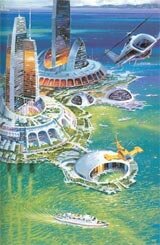During the nineteenth century, European and American artists flocked to Eastern cultures, from Morocco to India. Their works fueled the exotic and mythical perception of the Orient with cinematic depictions of islamic culture that continue to influence the arts today. These artists are commonly referred to as the Orientalists.
Last year while exploring and working in Marrakech I came across numerous books on or related to the topic. Following are some noteworthy selections.
If you’re ever in Marrakech, be sure to visit the oldest book store in Marrakech, open since 1948, it can be found within the medina’s souks. Publisher ACR also has a well stocked shop buried in Gueliz, the city’s French section.

Arabesques
“This volume throws light upon an art expression to be found clad in the garments of Moroccan architecture. A work that provides keys to the understanding of geometrical arabesques. An art of rare and precious mastery elaborated through the determined efforts of generations of anonymous artists. A brief historical survey defines the specificity of Islamic art in Morocco. Three principal styles of decorative architecture are studied: calligraphy, floral arabesque, and geometrical arabesque. Illustrations and photographs of some of the most beautiful sites of Morocco (monuments, royal palaces and cities) are a pleasure for the eye.” 700 Reproductions.
Editor’s Note: Arabesques are elaborate repeating geometric forms that commonly adorn Islamic architecture. Replete with numerous photos, illustrations and even a few visualizations by french VFX firm BUF, this slipcased tome clarifies their composition and reveals the structure behind the muqarnas, stalactite elements used in archways and domes. This is the finest book on the topic and one of the few titles available in English from French publisher ACR.
Slipcase Hardcover | 440 pages | ACR Edition | April 1999


L’Architecture Sacree De L’Islam (Sacred Architecture of Islam)
“The history of the sacred architecture of Islam reveals a surprising degree of unity and coherence, the result of the continuous expansion of the Muslim religion that lasted 800 years and was world-wide in its scope, before subsiding in the 16th century. The many representative examples contained in this richly-illustrated album offer an overview permitting even the casual reader to follow the successive transformations and stylistic variations on a country-by-country basis.
The text and illustrations cover twenty-one countries, all of which were touched by the wave of Islamisation in the course of their history.
Originating in the holy city of Medina, the current proceeded in three separate directions: North Africa and Spain, Central Asia and Central Europe. This system of geographical analysis permits a comparative study of the regional specificities of the monuments and edifices common to each zone, based on their respective architectural plans, interior and exterior volumes and decorative elements.
The first two chapters of the study contain an explanation of the religious and architectural considerations necessary for formulating a general overview of the subject, while the third chapter is devoted to specific and representative examples of Islamic architecture throughout the world.”
Editor’s Note: For Westerners, the sacred nature of Mosques allow only Muslim followers to enter, so to many, the fine architecture of Islam is not fully appreciated. This large book, featuring 1500 photos, lifts the veil. Only available in French.
Slipcase Hardcover | 480 pages | ACR Edition | March 1997


Medersa de Marrakech
“Captures the daily life inside and around the Ben Youssef Medersa. Richly illustrated with full page photographs and statements, bringing to life one of the most prestigious monuments of Marrakech.”
Editor’s Note: Perhaps the greatest piece of architecture in Marrakech. The Ben Youssef Medersa, now open to the public, was once the largest muslim school in all of Africa. The detail and alignment of architectural elements is a sight to behold, beautifully captured through atmospheric photographs. A complete overview with plans and detail illustrations. Unfortunately numerous copies of this French language publication are plagued by residual glue, resulting in stuck and ultimately damaged pages. Check copy prior to purchasing.
Slipcase Hardcover | 192 pages | Edisud | 1999


Orientalists: Western Artists in Arabia, the Sahara, Persia & India
“Americans and Europeans have a dual perception of the land that stretches from Morocco to India. Much of it Muslim, for the past 1,000 years no region has inspired more fear for the West, yet none has been a greater source of wonder and a stronger influence on Western art and artists. Contemporary events have darkened that perception, yet from the Great Pyramids to the Taj Mahal, the Middle East and India have for centuries lured Westerners to travel and have inspired their architecture, literature, music and fashion.
The Orientalists pursues perhaps the richest era of this long tradition of fascination for the Near and Middle East?the mid to late 19th century, when painters from America and from every country in Europe traveled in and painted the vast cities and peoples of North Africa, the Holy Land, Persia and India. Many of these regions had only recently become accessible to the West. The first in, the first to see ? the painters, known as “Orientalists” created a rich body of work of a world that was rapidly changing, during the last precious years before modernization.
The Holy Land, North Africa, Persia, India - these are places whose history is filled with both beauty and pain. The artists painted many sides that captured this duality?the dignity of faces, and the powerful color and beauty of architecture, calligraphy and clothing, but also the brutality of poverty and the tragic outcomes of violence.
The cinematic appeal of the images is undeniable. Hugely popular in their time, the Orientalists had an enormous influence on early film makers like D.W. Griffith and their recreations of Babylon and Biblical times. A perusal of the images in this book shows their deep influence on many aspects of contemporary visual arts, a kind of prototype of many 20th-century favorites, from the “Star Wars” films, “Lawrence of Arabia”, “Gladiator” and the many films set in the desert milieu, to the “Dune Chronicles,” Frank Frazetta and “The Lord of the Rings” illustration tradition.
Featuring over 300 images, culled from 45 different institutions in seven different countries, many of these pictures have rarely been seen publicly since their creation a century and more ago. Having both traveled and lived in the region, author Kristian Davies approaches this often misunderstood genre of art from a fresh perspective. The book is designed to be a primer, a fresh new approach and redefinition of the genre. Richly illustrated with full color pictures, many with second details, it is an art history book that puts the artwork first. Davies uses a selection of the finest pictures in the genre to illuminate the life and customs of this extraordinary part of our world. The text is intended for the general reader, exploring diverse subjects like deserts and pilgrimages, villages and bazaars, faith and spirituality, and the West?s enduring fascination with the harem and hookah.”
Editor’s Note: Atop the pantheon of books on Orientalist Painters. A highly prized volume, the Orientalists went out of print earlier this year and the publisher has confirmed that it will not be reprinted. If you can get your hands on a copy, don’t hesitate.
Hardcover | 304 pages | Laynfaroh | August 2006

Over India: Kite’s Eye Photographs of India
“Aerial photography is prohibited in India. It can only be done with permission from various government agencies. It is for this reason that there are hardly any substantial books on India from the air. For the first time, Nicolas Chorier achieves this feat by using the fascinating technique of kite photography (taking aerial pictures by using a kite to lift the camera). This book showcases the finest work of the French photographer, who has been shooting in India for many years. Seen here are unique and spectacular views of the wonders of India; jewels such as Amber Fort, Mehrangarh Fort, Nagaur Fort, Pushkar, Chittorgarh, Taj Mahal, Hampi, Mamallapuram and the beaches and backwaters of Kerala. Accompanying the pictures is the photographer?s anecdotal take on his India odyssey. For anyone who loves India and its rich heritage, this lavish book is a sumptuous treat for the eyes.”
Editor’s Note: Everything from Jaipur to the banks of the Godavari. Among the finest aerial photography books ever published.
Hardcover | 192 pages | Anova | November 2007


Palaces and Gardens of Persia
“In both decoration and design, the grand buildings and gardens of traditional Persia consistently refer to “paradise.” The very word itself refers to a sense of heavenly perfection, derived from an early Iranian term for “the Shah’s royal hunting grounds.”
The fine touches of heaven that lie behind the colorful tiled fa�ades of palace pavilions and mosques still shine in this richly illustrated and scholarly work. Enter gardens with intricate fountains and majestic ponds fed by water that is sourced from underground aqueducts dating to the 6th century. From ancient mirrored shrines of Shiraz and geometric gardens of Kashan to the ornate domes of Ispahan, here is a glorious photographic timeline drawn in water, brick, and ceramic ornamentation along the 3,000 years of the region’s architecture.”
Editor’s Note: Perhaps the finest book on landscape architecture I came across during my work in Marrakech. Currently on sale for $27.95 (57% off) at Strands in New York.
Hardcover | 299 pages | Princeton Architectural Press | April 2002


Steps to Water: The Ancient Stepwells of India
“In this broad historical and cultural overview, photographer and scholar Livingston (Philadelphia Univ.) shares her passion for western Indian stepwells and stepped ponds. A distinctive, often highly decorated communal Hindu architecture object, with origins in the seventh century in the semiarid regions of Gujarat and Rajasthan, stepwells reached their peak from 900 to 1300 C.E. as elaborate water buildings that were invested with ritual and social meanings. These passive water collection systems, designed to preserve monsoon rains, were modified by Muslims and Mughals into the mid-19th century, when British colonialism effectively shut them down. The erudite text presents building types, engineering, functions, art, ecology, and changes through the centuries, including sanitation and preservation concerns. Livingston’s poignant photographs capture the decayed and neglected condition of many sites. Maps, a chronology, a glossary, and even a bibliography of stepwell literature make this the definitive work in English.” 142 color, 92 b/w illustrations.
Editor’s Note: Steps to Water captures the ancient stepwells of India, as seen in films from The Fall to Baraka. “Think of Egypt’s great pyramids, inverted and elegantly lodged in the earth to serve a subcontinent’s thirst for water. That’s the role of India’s stepwells and stepped ponds, which, from the 5th through 19th centuries, served to catch water from the monsoons and save it for drinking, washing and bathing. These stone buildings, some as deep as nine stories with elaborate carved walls, columns and towers” evoke the drawings of M.C. Escher.
Hardcover | 120 pages | Princeton Architectural Press | April 2002










